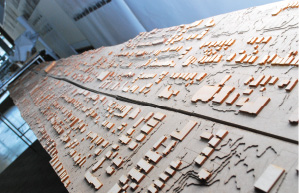
By LESLIE COLLINS
Northeast News
November 7, 2012
Historic Northeast has overtaken the downstairs of the Kansas City Design Center, 1018 Baltimore Ave.
Intricate maps and graphs of Northeast plaster the walls, ranging from peak times on bus routes to texture overlays that reveal density to topography influences and more.
On one side of the room, an 18-inch by 20-foot scale model of the Independence Avenue Corridor sits on a table. Everything, including the buildings, are done to scale and shape.
Sixteen Kansas City Design Center students, now in the final year of their master’s program, are studying the Independence Avenue Corridor to create a design vision plan. It’s a yearlong class project, but also folds into the $150,000 Planning Sustainable Places grant from the Mid-America Regional Council (MARC) that Historic Northeast recently received.
MARC commissioned the Kansas City Design Center to study Northeast and create design ideas for different sections along the corridor.
Asked how this study differs from past studies and planning documents, KC Design Center architecture student Jeremy Nelson said, “It takes a step beyond a planning document. Rather than just providing zoning or written ideas, it provides actual visual representations of what it could look like and designs for different points (along the corridor) and for the entire corridor that shows what it could be with investment, as well as all the things that go into a planning document.”
Nelson also stressed the students aren’t trying to redo previous plans. Instead, they’re aiming to build upon previous plans and incorporate elements that may have been missed previously.
“My hope is with the Independence Avenue Plan, we can start to connect the other vision plans, like the Truman Plaza Area Plan, the 5 Points Community Vision Plan, and all these documents to do our work and create an overall vision plan,” KC Design Center Professor Vladimir Krstic said. “What’s happened in recent history in Kansas City is very often we go and do projects and sometimes these projects are in contradiction and competition with something else… We hope that (design vision plan) can be used for some future decisions of implementation.”
Past study projects at the KC Design Center have included the downtown loop, West Bottoms, Crossroads District, Crown Center area, among others. This is the first time the center has studied the Northeast area.
Since the end of August, the students have been studying Northeast and meeting with Northeast stakeholders. A number of students attended the Sept. 8 Northeast Taste and Tour sponsored by the Northeast Kansas City Chamber of Commerce. Those who attended later mirrored the Chamber’s tour highlights to give a tour to the entire class.
Students recently completed the analytical phase of the project and will now move on to create an overall urban vision plan for Independence Avenue, as well as create individual design elements for certain sections along the corridor.
Those elements can range from infill strategies to making the corridor more pedestrian friendly to adding attractive landscaping to parking lots, among other elements, Krstic said.
Creating cohesiveness is also key, which can be done through items like quality sidewalks, street lights, street landscaping and the appearance of bus stops, he said.
Once complete, the study, along with the urban vision plan and renderings, will be incorporated into a paperback book.
“All these things (in the book) become objects they (community) can use to inspire development and involvement of more community members,” KC Design Center architect student Nick Fratta said.
Having tangible design ideas also helps when approaching developers, Fratta said.
“Every day we discuss a new character of the community,” Fratta said. “Every time we cross-reference different pieces to this problem, we find new ideas and new directions to go.
“It goes beyond just trying to complete your assignment for school. We’re getting our first taste of the responsibility this profession entails.”
One of the goals of the project is to create a strategic set of ideas that are implementable, Krstic said.
“Another goal,” Krstic said, “is to create a compelling vision with significant community buy-in of something that reflects their aspirations and values, but takes it beyond what they imagine. It gives them something to aspire for.”














